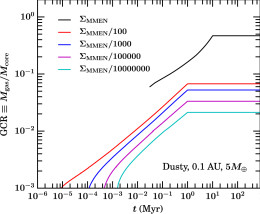Short-period super-Earths — planets larger than Earth, but smaller than gas giants — have been found orbiting ~60% of Sun-like stars around us. But how do these planets form? A new study proposes a mechanism for birthing these contradictory planets, as well as their rarer counterparts, “super-puffs”.
Two Formation Puzzles
Super-Earths are exoplanets with radii of 1–4 Earth radii and masses of 2–20 Earth masses. These numbers pose a puzzle: this mass range includes cores massive enough that they should trigger runaway accretion and result in the formation of gas giants. Yet super-Earths don’t accumulate that much gas: their atmospheres are only 1-10% the mass of their core. How do these planets manage to avoid runaway accretion?
Super-Earths may often have too little gas for their large core masses, but the flip side of this puzzle is that of super-puffs. Super-puffs are a rare class of short-period Kepler planets with the opposite problem: they have too much gas relative to their core mass. Super-puffs have large radii of 4–10 Earth radii, but small masses of 2–6 Earth masses. Their atmosphere-to-core ratios are > 20%.

The final planet atmosphere-to-core mass ratio for models with different factors of gas depletion in the inner disk. The ratio is too high (like a gas giant) if the disk is not depleted (black curve), but it’s in the range of 1-10% if the disk is depleted by a factor of 100 to 10,000,000 (colored curves). [Lee&Chiang 2016]
A Late Birth
Lee and Chiang found that super-Earths are able to form without running away and becoming Jupiter-like — if they aren’t born until late in the game! The inner regions of the gas disk surrounding the host star will gradually clear out over time. Planetary cores that assemble and accrete gas at the tail end of the inner disk’s lifetime — when most of the gas is already depleted — will be able to grow only small atmospheres. The limit is primarily set by the timescale: these planets have only 1 Myr to form, rather than 10 Myr, so they run out of time before running away.
The minimal gas in the inner disk in this scenario means there’s also little friction to cause migration of the planetary core. The authors demonstrate that this supports in situ formation of these super-Earths close to the host star.
![Schematic of a transitional disk, in which the inner regions have been cleared of gas. [Catherine Espaillat]](https://aasnova.org/wp-content/uploads/2016/04/fig31-260x195.jpg)
Schematic of a transitional disk, in which the inner regions have been cleared of gas. [Catherine Espaillat]
Formation at a Distance
As for super-puffs, the authors’ calculations show that these planets can build their thick atmospheres further out in the disk (at distances beyond ~1 AU), where the nebular gas is colder and less dense. The rapid cooling of their dust-free atmospheres allows them to amass gas much more quickly. After building their atmospheres, the super-puffs then migrate inwards to their currently observed orbits < 0.1 AU from their host stars.
With these scenarios, the authors are able to reconcile the puzzles of both super-Earths and super-puffs with the model of planet formation via nebular accretion. Intriguingly, their proposed picture of super-Earths — forming in a gas-poor inner disk that’s fed by gas bleeding inward from a massive outer disk — is consistent with observations of transitional disks that have their inner regions cleared of gas. Future observations of such disks may help to confirm this formation model.
Citation
Eve J. Lee and Eugene Chiang 2016 ApJ 817 90. doi:10.3847/0004-637X/817/2/90


3 Comments
Pingback: New Study May Solve Super-Earth Formation Mystery | Space Leaks | Space & Astronomy News
Pingback: New Study May Solve Super-Earth Formation Mystery – Latest Science News
Pingback: New Study May Solve Super-Earth Formation Mystery – Wonder Of Science